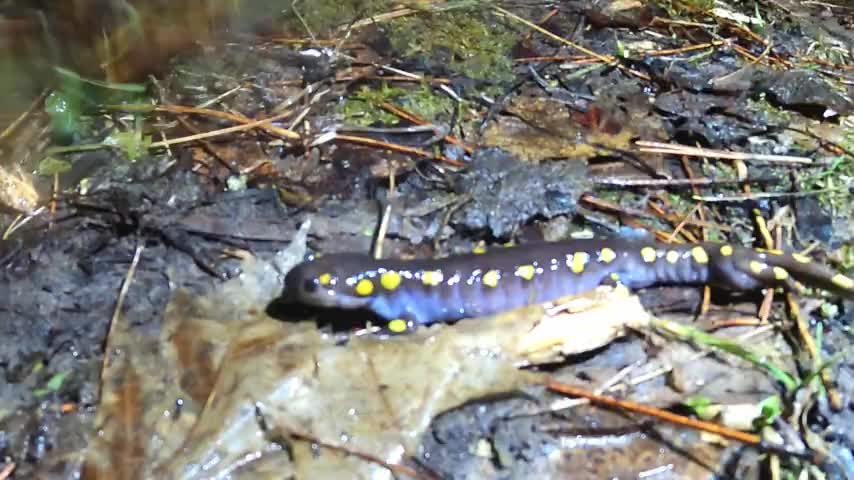Premium Only Content

Researchers find mutated salamander growing an extra leg
The great spring salamander migration is an incredible thing to witness. Normally hidden from view, salamanders are one of the most plentiful vertebrates in almost any North American forest. They make up the majority of vertebrate biomass and it is now believed that they are likely 10 times as numerous as was recently estimated. They hide in the ground, under logs and decaying leaves, in burrows and anywhere that gives them shelter from the light and lack of humidity.
Salamanders must keep moist in order to breathe through their skin. They have lungs as adults, but they cannot survive without moisture. They are literally everywhere beneath our feet as we explore the forests around us. They make up a significant part of the food web, preyed upon by foxes, skunks, snakes, birds, and almost any carnivorous creature large enough to swallow them. And these animals in turn, become food for the larger predators in the woods.
In the spring, within days of the vernal ponds melting, the salamanders migrate en masse to the pools to breed. They arrive almost simultaneously, driven by natural instinct that creates a spectacle worth waiting for. These researchers have watched for the right conditions; a mild night after the water opens up, with the leaves and ground made wet with fresh rain. They have arrived at the pond, stepping carefully over the fragile little creatures that could easily be crushed underfoot. The salamanders are everywhere, and they are beautiful. A dark blue/black skin is adorned with bright yellow spots.
The salamanders move like lizards, although they are amphibians. They emerge from eggs in the water and grow into tadpoles, similar to frogs. They breathe by extracting oxygen from the water in their tadpole stage. They grow legs and lungs and venture onto land by the end of the summer, making their way to underground shelter where they will hibernate through the winter months. They will emerge in the spring and follow the others back to the pond where they were born. And the cycle continues, sometimes for up tp 30 years before the salamander dies.
Among the unique traits of the salamander is the amazing ability to regenerate limbs, organs, and even their brains. Scientists are fascinated with this ability and the applications that might assist with human medicine. These researchers have found a mutation in the midst of the thousands of normal salamanders. This one seems to be growing a second tail. But a closer look reveals that it is actually a fifth leg sprouting from the middle of the tail. A partially formed knee and foot can be seen.
The forest around us is full of mystery and fascinating things. If we are willing to look closely, it can be seen.
-
 2:04:10
2:04:10
LFA TV
1 day agoICE ICE BABY! | LIVE FROM AMERICA 1.27.25 11am
66.7K38 -
 1:01:03
1:01:03
The Dan Bongino Show
5 hours agoThe Rock-'Em-Sock-'Em Presidency (Ep. 2409) - 01/27/2025
687K970 -
 1:09:08
1:09:08
The Rubin Report
3 hours agoStephen A. Smith Makes Makes Bill Maher Go Quiet with His Scorching Attack on Democrats
81.2K41 -
 2:01:00
2:01:00
Steven Crowder
5 hours agoWe are So Back: How Trump Flexed American Muscle and Owned Colombia
401K220 -
 1:28:04
1:28:04
Caleb Hammer
3 hours agoHomewrecker Ruins EVERYTHING To Steal Married Old Men | Financial Audit
31.1K6 -
 1:28:49
1:28:49
The Shannon Joy Show
3 hours ago🔥🔥Bobby Kennedy Goes To Washington! Can He Tame The PHARMA Giant & STOP mRNA Expansion?🔥🔥
29K1 -
 38:57
38:57
Tudor Dixon
4 hours agoThe Woketopus: The Dark Money Cabal Manipulating the Federal Government | The Tudor Dixon Podcast
21K4 -
 11:34
11:34
MrBigKid
17 hours ago $1.13 earnedS&W Bodyguard 2 ... Why is it so different!?
23.4K -
 34:58
34:58
Rethinking the Dollar
3 hours agoUS Equities BREAKING POINT Exposed by Deep Seek AI!
15.5K5 -
 1:15:25
1:15:25
Graham Allen
6 hours agoTrump BULLIES Colombia Into Following His Policy!! + FINALLY PETE IS CONFIRMED!
97.8K95